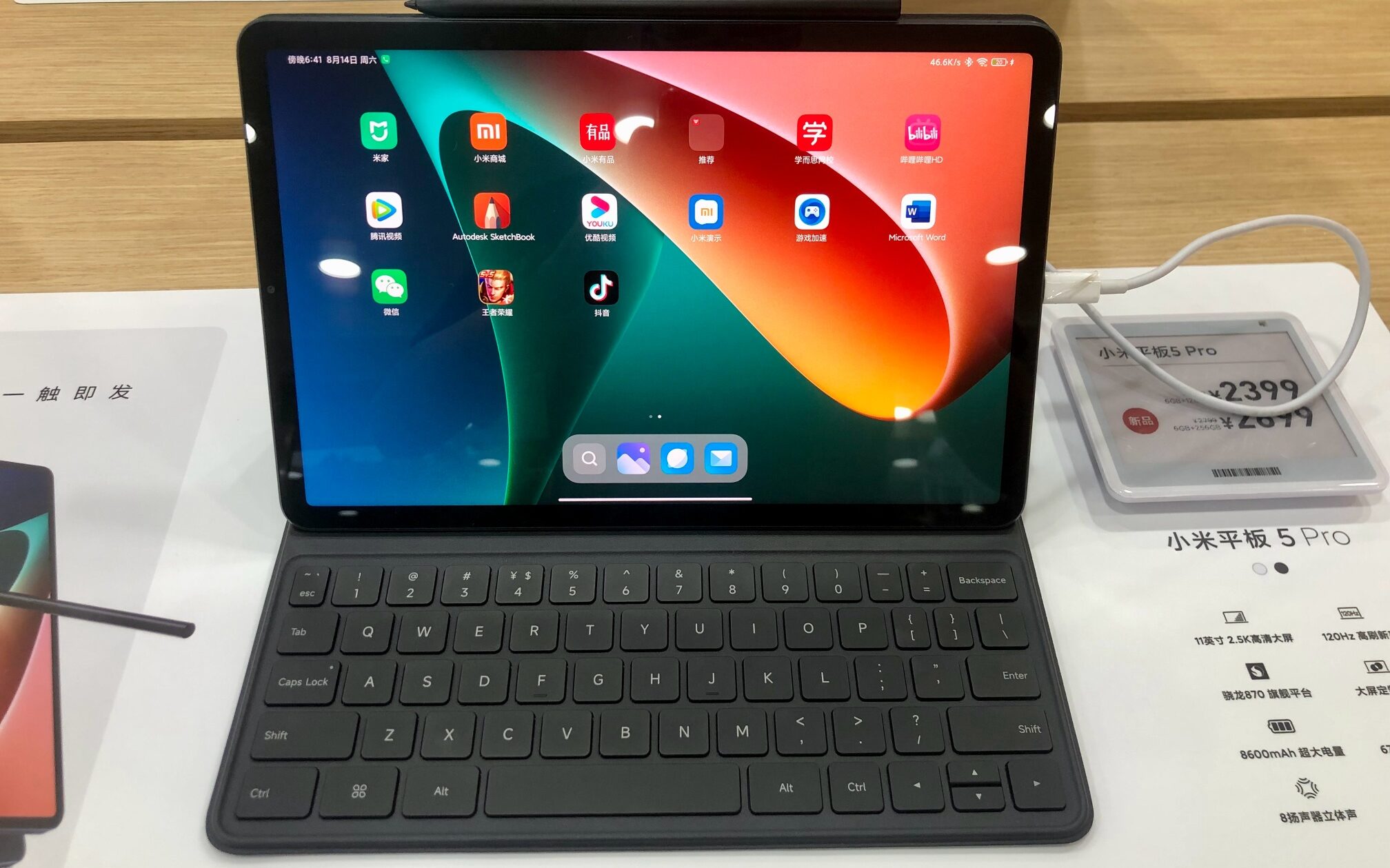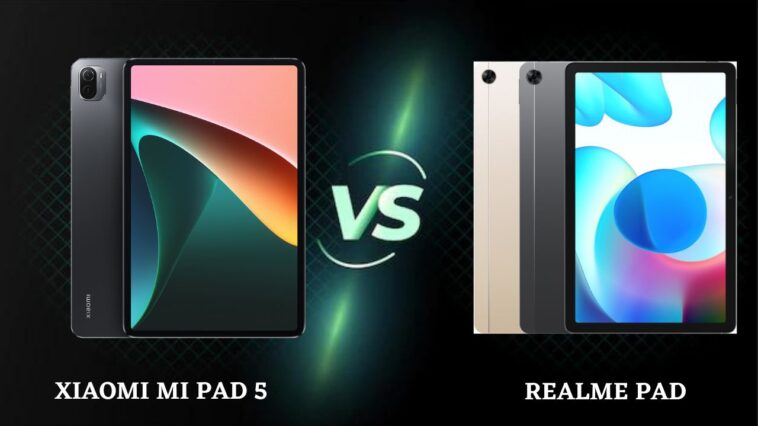Table of Contents
Realme has just introduced its new Pad X tablet in the Indian market, and on the surface, it seems like an attractive purchase—that is, unless you consider some of its competitors, like the Xiaomi Pad 5. Can the Realme Pad X surpass the Xiaomi Pad 5, which was widely praised by the public and the tech community, to become the best alternative?
The Realme Pad and Xiaomi Pad 5 tablets from both companies have been made available. The first tablet to come was the Xiaomi Pad 5, which has an 11-inch IPS LCD, a strong processor, and a large battery. However, the Realme Pad, the company’s first tablet, has a smaller 10.4-inch IPS LCD, a standard processor, and a durable battery. So, given their features and price tags, which of these tablets should you buy? Let’s find out who wins Xiaomi MI Pad 5 vs. Realme Pad.
Xiaomi Mi Pad 5 Vs. Realme Pad: Comparison Table
| Features | Xiaomi Mi Pad 5 | Realme Pad |
| Launching Year | 2022 | 2021 |
| Brand | Xiaomi | Realme |
| Model Name | Mi Pad 5 | Realme Pad |
| Series | Mi Pad | Realme Pad |
| OS | Android v11 | Android v11 |
| Display Resolution | 1600 x 2560 pixels | 1200 x 2000 pixels |
| Processor | Qualcomm Snapdragon 860 | Mediatek Helio G80 |
| RAM | 3 GB | 6 GB |
| SSD | 32 GB | 128 GB |
| Rear Camera | 8 MP with autofocus | 13 MP f/2 |
| Front Camera | 8 MP f/2 | 8 MP |
| Video Recording | 1080p @ 30fps FHD | 4K @ 30fps UHD, 1080p @ 30fps FHD |
| Online Pricing Range | ₹14,980 | ₹24,999 |
| Customer Ratings | 3.5/5 | 4/5 |
ALSO READ: HP Pavilion 15 Vs Dell Inspiron 16 5620: Which One You Should Buy?
Xiaomi Mi Pad 5 Vs. Realme Pad: Detailed Analysis
Design
The Xiaomi Mi Pad 5 looks better than other tablets because its screen-to-body ratio is higher. The Realme Pad has thicker bezels, while the display covers a larger portion of the front panel. The Realme Pad, on the other hand, is more portable, which makes it potentially more appealing to individuals who wish to use it while traveling. Although the Realme Pad weighs 440 grams less than the Xiaomi Mi Pad, they are almost identical in thickness at 6.9 mm. Both tablets have an aluminum frame and back, but the Xiaomi Mi Pad 5 has extra features that make it more reminiscent of a PC. While the Realme Pad lacks these features, the Xiaomi Mi Pad 5 allows you to attach a keyboard and even supports a pen for scribbling and sketching.
Camera

The Xiaomi Mi Pad 5 comes with an entry-level camera, but it is better than the Realme Pad because it has a 13 MP rear sensor and 4K video recording capabilities. The Realme Pad sports an 8 MP back camera that can capture 1080p videos at 30 frames per second.
Battery
Because the Xiaomi Mi Pad 5 is larger, a larger battery should have been expected. Realme Pad only has 7100 mAh and 18W fast charging, whereas the Mi tablet has an 8720 mAh battery with 33W fast charging, but it still has respectable battery life.
MUST-READ: Asus Tuf f15 Vs Asus Rog Strix G17: Which Is Best?
Features & Software
Choose the Xiaomi Mi Pad 5 if you require the maximum performance to run demanding programs or play games on your tablet. It is powered by the high-end Snapdragon 860 mobile platform, which is comparable in terms of CPU and GPU performance to the Snapdragon 865. The chipset is combined with 6 GB of RAM and internal storage that can be up to 256 GB using UFS 3.1.
With a low-end Helio G80 CPU and up to 4 GB of RAM and 64 GB of storage, the Realme Pad is rather disappointing for power enthusiasts, but it is still a fine chipset for the ordinary user. Realme Pad also comes with a unique version of Realme UI called Realme UI for Pad and is optimized for tablets, but Xiaomi Mi Pad 5 has the standard MIUI that can also be found on Xiaomi phones. A 4G version of the Realme Pad is available, although the Mi Pad 5 only has WiFi.
Storage and RAM

There are three RAM configurations for the Realme Pad: 3GB, 4GB, and 6GB. However, there is just one 6GB option on the Xiaomi Pad 5. Although they are equivalent in terms of having up to 6GB of RAM, the gadget may also be purchased for less money due to the lower RAM options.
The Xiaomi Pad 5 has storage options of 128GB and 256GB, while the Realme Pad has 32GB, 64GB, and 128GB. Although the Xiaomi tablet has more storage, the Realme tablet can increase its capacity by up to 1TB with a microSD card. Unfortunately, the Xiaomi Pad 5 lacks a microSD slot.
Connectivity & Other Features
Both the Realme Pad and Xiaomi Pad 5 operate on Android 11 and support the same connectivity technologies, such as WiFi 5, Bluetooth 5.0, and USB Type-C. Additionally, the Xiaomi Pad 5 is a WiFi-only tablet, in contrast to the Realme Pad, which has 4G LTE capability (4GB + 64GB and 6GB + 128GB models).
Both devices have Hi-Res Audio Certification and Dolby Atmos Quad Speakers for audio. The Realme Pad’s inclusion of a 3.5mm audio port, which enables you to connect connected audio devices, is a bonus.
READ MORE: Lenovo Thinkbook 14 Vs Lenovo Ideapad Slim 5: Which To Choose?
Xiaomi Mi Pad 5 Vs. Realme Pad: Quick Results
| Particulars | Xiaomi Mi Pad 5 | Realme Pad | Which One Is Better? |
| Design | Better | Good | Xiaomi Mi Pad 5 |
| Camera | Better | Good | Xiaomi Mi Pad 5 |
| Features & Software | Better | Good | Xiaomi Mi Pad 5 |
| Storage and RAM | Better | Good | Xiaomi Mi Pad 5 |
| Connectivity & Other Features | Good | Better | Realme Pad |
Xiaomi Mi Pad 5 Vs. Realme Pad: Final Verdict
If you don’t require a lot of RAM, the Realme Pad is a better choice for individuals seeking a cheap tablet because it offers more configuration possibilities. Similar to the Xiaomi Pad 5, it has a 6GB + 128G model but is 10K less expensive. You also get the advantages of expandable storage, LTE support, and a 3.5mm audio connector for your wired audio equipment.
The Xiaomi Pad 5 has more benefits, such as a bigger, better, and smoother 120Hz display, higher performance, a longer battery life, a better back camera, and support for styluses, so it is still a better choice. So keep in mind that these are the benefits you’ll get from spending 10,000 extra.





